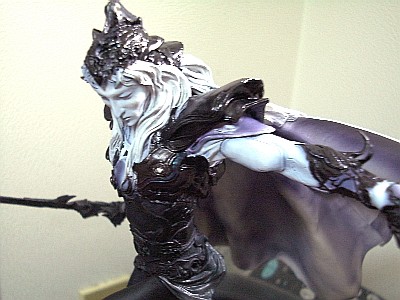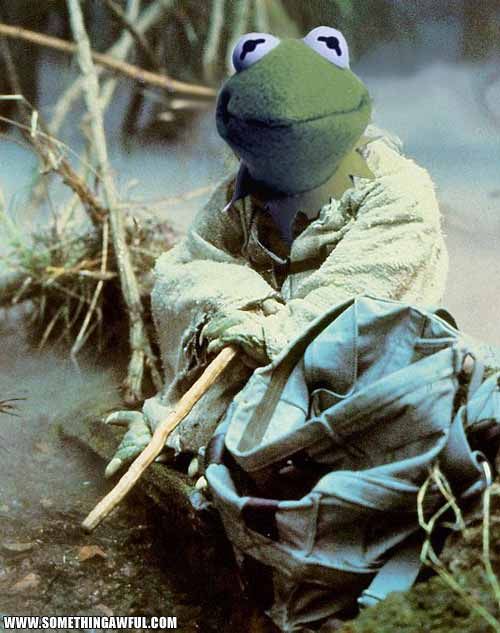Much Ado About Frodo
from Sploid
Spoilsport
 scientists have challenged the theory that the tiny skeleton from Indonesia dubbed the "Hobbit" is a new human species. Instead, they say that it may have been a modern human with a brain disorder.
scientists have challenged the theory that the tiny skeleton from Indonesia dubbed the "Hobbit" is a new human species. Instead, they say that it may have been a modern human with a brain disorder.The creature is believed to have stood just 3 feet tall, and had a brain the size of a chimp. Skeptical scientists say that's too small to give the brain power needed to create the tools found at the site.
"There is a fundamental problem of the tiny brain size combined with the sophisticated stone tools," according to biologist Professor Robert Martin.
Martin and his associates are claiming that the skull is not that of a newly-discovered but extinct species. Instead, they think it is a modern human afflicted with microcephaly, a genetic disorder which causes a smaller than normal brain and head size.
Meanwhile, the Aussie co-discoverer of the Hobbit has dismissed the criticism. Dr Peter Brown says the debunking scientists are making a big mistake in looking at just the one skeleton. As he points out, there are actually skeletal remains of multiple Hobbits from a range of different times, which would seem to rule out the brain disorder theory.
Martin's answer is that the other remains do not include a skull. "It's perfectly plausible that these were pygmy people," he says. "But there's only one skull, and that is human and microcephalic."
However, Brown claims there is other supporting evidence to back his claim which is being ignored, and says the reason why the Hobbit theory is coming under attack is simple - it challenges ingrained beliefs. "Some people see exactly what they want to see, for a variety of reasons," he explains.
The Hobbit has been a controversial discovery because scientists think the remains are from as little as 12,000 years ago, a time when Neanderthals and our other cousins had all died out. Its discoverers believe it may have lived in a miniature 'lost world', inhabited not only by Hobbit-sized people but also dwarf elephants. They also believe they may have been the first Australians.
Cryptozoologists and scientists alike have also suggested that the discovery of the creature may be a boost to the search for Bigfoot. Locals in the area have myths about short, furry people living in the jungle, much like modern America has myths about very tall, furry people.
"You pick a country and there's either large Bigfoot and Yetis, or small leprechauns and Yowies, depending on which part of the world you're in," says Brown. "On Flores there is a mythical human-like animal called Ebu Gogo, known for small body size, inarticulate speech and an unusual bipedal gait."
Even the editor of the prestigious journal Nature, Henry Gee agrees. "The discovery that Homo floresiensis survived until so very recently, in geological terms, makes it more likely that stories of other mythical, human-like creatures such as Yetis are founded on grains of truth," he says. "Now, cryptozoology, the study of such fabulous creatures, can come in from the cold."







 It will be all new characters. It will be the missing twenty-year period during Luke growing up. Think about bounty hunter, that's all I can tell you. It's no one else that you will know. It's really early stages, and we haven't sat down to decide what direction to go."
It will be all new characters. It will be the missing twenty-year period during Luke growing up. Think about bounty hunter, that's all I can tell you. It's no one else that you will know. It's really early stages, and we haven't sat down to decide what direction to go." 
 horrific disease is eating its way across the South. It causes black beads of sweat, painful black hairs and tiny bugs to come out of your skin. If you're lucky you only suffer from open sores. It makes a
horrific disease is eating its way across the South. It causes black beads of sweat, painful black hairs and tiny bugs to come out of your skin. If you're lucky you only suffer from open sores. It makes a  of these patients do have
of these patients do have  George Lucas is looking for a lot more than just fortune and glory these days.
George Lucas is looking for a lot more than just fortune and glory these days.


 Ratner, director of the upcoming SF sequel X-Men: The Last Stand, told SCI FI Wire that the third installment in the hit comic franchise is loaded with both huge set pieces and quieter, more reflective character moments.
Ratner, director of the upcoming SF sequel X-Men: The Last Stand, told SCI FI Wire that the third installment in the hit comic franchise is loaded with both huge set pieces and quieter, more reflective character moments. 
 for a quieter moment? Ratner pointed to a spoiler scene between Wolverine (Hugh Jackman) and a pre-Dark Phoenix Jean Grey (Famke Janssen). "Wolverine is looking at Jean after she's come back," Ratner said. "They're in the infirmary, and he's looking down at her. It's a great moment, because you see that he loves her. He's staring at her with love, because he doesn't know if she's going to live or die, and all of a sudden she grabs his hand. That's reminiscent of [a similar scene in] the first movie, when he grabbed her after he'd been unconscious, when she was looking at him, in a different way, of course. But that, I thought, was a beautiful moment."
for a quieter moment? Ratner pointed to a spoiler scene between Wolverine (Hugh Jackman) and a pre-Dark Phoenix Jean Grey (Famke Janssen). "Wolverine is looking at Jean after she's come back," Ratner said. "They're in the infirmary, and he's looking down at her. It's a great moment, because you see that he loves her. He's staring at her with love, because he doesn't know if she's going to live or die, and all of a sudden she grabs his hand. That's reminiscent of [a similar scene in] the first movie, when he grabbed her after he'd been unconscious, when she was looking at him, in a different way, of course. But that, I thought, was a beautiful moment."  Favreau is set to direct Marvel Studios' live-action movie Iron Man, which will now be distributed by Paramount, part of a slate of directing and writing deals Marvel announced, Variety reported. Iron Man is Marvel's top priority and will be written by Arthur Marcum and Matt Hollaway (Convoy).
Favreau is set to direct Marvel Studios' live-action movie Iron Man, which will now be distributed by Paramount, part of a slate of directing and writing deals Marvel announced, Variety reported. Iron Man is Marvel's top priority and will be written by Arthur Marcum and Matt Hollaway (Convoy).  for The Incredible Hulk, a sequel to 2003's Hulk.
for The Incredible Hulk, a sequel to 2003's Hulk. 




 of the reasons thirtysomethings get so pissy about Lucas' crimes against continuity is that what they really want is the original sense of wonder, joy and possibility that the movie instilled in them before a deadening, crushing world sucked it right back out again. This edition comes with a brain probe that turns you into an 8-year-old again, at least mentally. You'll watch the entire movie with your mouth wide open, then you'll run around the house making lightsaber noises during the credits. As an added bonus, if you apply the probe twice, you'll turn into a 4-year-old, which will allow you to enjoy the jokes in The Phantom Menace.
of the reasons thirtysomethings get so pissy about Lucas' crimes against continuity is that what they really want is the original sense of wonder, joy and possibility that the movie instilled in them before a deadening, crushing world sucked it right back out again. This edition comes with a brain probe that turns you into an 8-year-old again, at least mentally. You'll watch the entire movie with your mouth wide open, then you'll run around the house making lightsaber noises during the credits. As an added bonus, if you apply the probe twice, you'll turn into a 4-year-old, which will allow you to enjoy the jokes in The Phantom Menace. Matt Feshbach believes he has super powers. He senses danger faster than most people. He appreciates beauty more deeply than he used to. He says he outperforms his peers in the money management industry.
Matt Feshbach believes he has super powers. He senses danger faster than most people. He appreciates beauty more deeply than he used to. He says he outperforms his peers in the money management industry. 52, and his two brothers became famous in investment circles during the 1980s as the kings of short selling stocks - essentially betting which stocks will tank. At one point, the California-based Feshbach Bros. managed $1-billion for clients.
52, and his two brothers became famous in investment circles during the 1980s as the kings of short selling stocks - essentially betting which stocks will tank. At one point, the California-based Feshbach Bros. managed $1-billion for clients. said he has no idea how Super Power will be set up, but is excited about the parts on ethics and perceptics, which he likened to a "trip to Disney."
said he has no idea how Super Power will be set up, but is excited about the parts on ethics and perceptics, which he likened to a "trip to Disney."

 Apparently Abrams is coming down to visit the set in a few weeks, to visit Michelle Monaghan, whom he directed in Mission: Impossible 3, so that might add some more fuel to the fire. If it comes off, he's apparently playing the hero. Don't know if that's Captain Kirk or some other nameless male protagonist...but that's the gist of it. So possible that Affleck's going to go onto doing a new Jack Ryan, and possibly a Trek, after he finishes with this film.
Apparently Abrams is coming down to visit the set in a few weeks, to visit Michelle Monaghan, whom he directed in Mission: Impossible 3, so that might add some more fuel to the fire. If it comes off, he's apparently playing the hero. Don't know if that's Captain Kirk or some other nameless male protagonist...but that's the gist of it. So possible that Affleck's going to go onto doing a new Jack Ryan, and possibly a Trek, after he finishes with this film. the eve of the E3 convention, Warners-based Legendary Pictures has acquired movie rights to Blizzard's award-winning World of Warcraft video game series and plans to produce a live-action film based on the hugely popular property reports the trades.
the eve of the E3 convention, Warners-based Legendary Pictures has acquired movie rights to Blizzard's award-winning World of Warcraft video game series and plans to produce a live-action film based on the hugely popular property reports the trades.






 Bros. Pictures has hired scribe Travis Beacham (Killing on Carnival Row) to pen a remake of the 1981 cult classic Clash of the Titans reports Variety.
Bros. Pictures has hired scribe Travis Beacham (Killing on Carnival Row) to pen a remake of the 1981 cult classic Clash of the Titans reports Variety. complete various tasks set out by Zeus, including capturing Pegasus and slaying Medusa.
complete various tasks set out by Zeus, including capturing Pegasus and slaying Medusa. 2002, the studio previously tapped John Glenn and Travis Adam Wright to pen a script which would cut out much of the 'Gods on Olympus' elements from the original - drawing a lot of ire from fans. Beacham however plans to keep it in.
2002, the studio previously tapped John Glenn and Travis Adam Wright to pen a script which would cut out much of the 'Gods on Olympus' elements from the original - drawing a lot of ire from fans. Beacham however plans to keep it in.

 and Danny Dimbort's Millennium will finance and produce the movie with Emmett/Furla. The project's budget is north of $25 million
and Danny Dimbort's Millennium will finance and produce the movie with Emmett/Furla. The project's budget is north of $25 million
 TV is set to unveil an awards-show franchise devoted to the booming horror/science fiction genre, according to The Hollywood Reporter. The Viacom-owned cable network is working on Scream 2006, which likely will air in October. Scream is scouting Los Angeles locations to shoot the event in September.
TV is set to unveil an awards-show franchise devoted to the booming horror/science fiction genre, according to The Hollywood Reporter. The Viacom-owned cable network is working on Scream 2006, which likely will air in October. Scream is scouting Los Angeles locations to shoot the event in September. 
 what the Great Conjunction is. 'What's the Great Conjunction?'
what the Great Conjunction is. 'What's the Great Conjunction?' 





 A Is for Androids
A Is for Androids B Is for Boba
B Is for Boba C Is for Calvin
C Is for Calvin D Is for Dragons
D Is for Dragons E Is for Elric
E Is for Elric F Is for Futures
F Is for Futures G Is for Genie
G Is for Genie H Is for Hobbits
H Is for Hobbits I Is for Iceman
I Is for Iceman J Is for Jedi
J Is for Jedi K Is for Kraken
K Is for Kraken
















































































